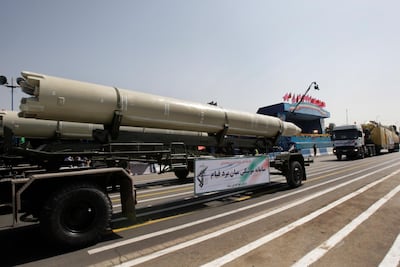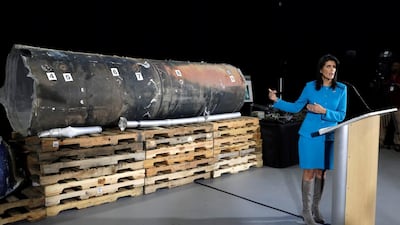The United States on Thursday publicly presented "undeniable evidence" that a missile fired by Yemeni rebels at Riyadh international airport last month was supplied by Iran.
The missile is among a range of weapons being provided by Tehran as part of its destabilising activities in the region, ambassador to the United Nations Nikki Haley said as she laid out the recent findings communicated in the UN’s 2231 Implementation Report.
Speaking from a military base in Washington, DC, Ms Haley said the missile parts bore markings showing they originated in Iran and had technical specifications that are specific to Iranian-manufactured weapons.
_______________
Read more:
Saudi Arabia welcomes UN report on Iran's support for Houthi militias
_______________
"It was made in Iran then sent to Houthi militants in Yemen. From there it was fired at a civilian airport with the potential to kill hundreds of innocent civilians in Saudi Arabia," she said.
Ms Haley also listed attack drones, explosives-laden boats designed to be rammed into targets and anti-tank rockets among the weapons found to have been supplied by Iran.
She said other governments had been invited to examine the US findings. Iran's UN mission quickly issued a statement claiming that the evidence had been "fabricated".
Ms Haley said the US was working towards a co-ordinated international effort to counter Iran's actions. "You will see us build a coalition to really push back against Iran and what they're doing," she said.
Nicholas Heras a fellow at the Centre for New American Security, said Ms Haley’s announcement was in line with “the Trump administration commitment to counter Iran's Hizbollah proliferation policy in the region".
“Iran has used the Yemeni conflict as a pretext to turn the Houthis into a Yemeni Hizbollah that the Revolutionary Guards can outfit with missiles to threaten Saudi Arabia and apply pressure on vital international maritime routes that go around the Bab Al Mandeb,” said Mr Heras, who studies the Middle East and defence issues.
Strategically, it means that Washington could be “gearing up to support Saudi Arabia's ‘escalate to de-escalate’ strategy, which is to apply overwhelming military force to seize key Yemeni cities from Houthi control, and to box the group into a corner”, he said.
_______________
Read more:
UAE and Saudi Arabia hold talks with Yemen's Al Islah party
Yemen: Prime minister of Houthi-Saleh administration agrees to work with rebels
_______________
In order to do that, “the Trump team wants to first make sure that the international community is crystal clear the threat that Iran's Houthi partners are to international security”, which drives Ms Haley’s efforts, he added.
In sum, the Trump administration stance on this issue “is taking a name and shame approach to applying diplomatic pressure on Iran over its malign activities in Yemen”, Mr Heras said. “It will not allow the Iranians to try to obfuscate their leading role in destabilising this strategic and globally significant region of the Arabian Peninsula.”

A military analyst contacted by The National ahead of Ms Haley's presentation said there was "growing evidence" that Iran had supplied missiles used by the Houthis against Saudi Arabia in two attacks this year.
A spokesman for the Houthi rebels claimed on November 4 that the weapon they had launched at the Saudi capital was Burkan-2H missile. This weapon, which is a variant of the Scud missile family and is also known as the Volcano H-2, has a range of 800km and was first used on July 22 when it was launched at the Saudi region of Yanbu.
However, according to Jeremy Binnie, Middle East editor for Jane's Defence Weekly, "given that Yemen has no known history of producing its own ballistic missiles, let alone extended range Scud versions, the emergence of the … Burkan missiles appears to support the claims made by the coalition and US officials that Iran is extensively involved" in providing ballistic missiles to the Houthis.
Mr Binnie told The National that "there is a growing amount of evidence that Iran has at the least provided components to modify Yemeni ballistic missiles and probably entire missiles for more recent attacks. This is the most obvious explanation for the existence of ballistic missiles with a range of around 900km in Yemen, although it is still a mystery how such large items are being smuggled into the country."
Last month, Jane's published a document which suggested that the missile was indeed an Iranian Qiam, which is also a Scud-related system and which has a similar range to the Burkan. It lacks the fins that most Scuds possess, which makes it harder to track by radar and also increases the range and the payload of the missile. It was first revealed in 2010 and was used in combat for the first time in June this year, when Iranian forces targeted ISIL fighters in Syria's eastern Deir Ezzor region in retaliation for terror attacks in Tehran.
The dossier, which was released by the Saudi-led coalition backing the government in Yemen, featured photos of a recovered section of one of the two Houthi missiles fired at Saudi Arabia this year. One photograph showed that the missile carried the same markings as seen in a photo of a Qiam which was released by the Iranians in 2010. Another photograph appeared to show that the recovered missile shared the same steering mechanism as has been identified on the Qiam.
Mr Binnie, who wrote the accompanying story, said “the document also noted that the warheads seen on the Burkan-2s that the rebels have displayed were the same shape as the ones used on the Qiam and that the launcher briefly seen in a rebel video of a Burkan-1 attack was pulled by a civilian tractor like Iranian systems, not mounted on an all-terrain military vehicle”.
He also noted on Twitter that in the video released by the Houthis to claim the November launch, “the rebels appear to have obscured the rear of the Burkan-2H. Are they trying to hide a finless Qiam from Iran?”
Michael Elleman, senior fellow for missile defence at the International Institute for Strategic Studies, told The National that "earlier reports had presented nothing of real substance to determine the origins of the missile that hit Riyadh. All told, if the evidence includes an analysis of the material of construction - steel vs aluminum alloy — one could draw some definitive conclusions. If it is made from steel, most likely the missile was part of the 2002, or 2006, shipments from North Korea."
After the Ms Haley's presentation, Mr Elleman tweeted that the evidence was "compelling". Citing the "unique arrangement of fueling/venting ports" and use of aluminium alloy in its construction, he declared: "This is an Iranian Qiam missile."

